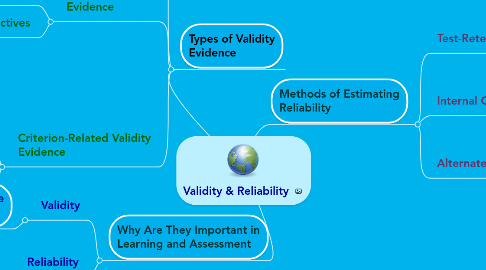
1. Why Are They Important in Learning and Assessment
1.1. Validity
1.1.1. Measure what they are intended to measure
1.2. Reliability
1.2.1. Will use the same or similiar scoring systems to maintain consistency
2. Types of Validity Evidence
2.1. Construct Validity Evidence
2.1.1. Q: Does the relationship to the onformayion correesspond with a theory?
2.1.2. A: Determine if the results of the test correspond with what you thought
2.2. Content Validity Evidence
2.2.1. Q: Do test items match and measure objectives?
2.2.2. A: Match the items with objectives
2.3. Criterion-Related Validity Evidence
2.3.1. Concurrent Criterion-Related Validity Evidence
2.3.1.1. Q: How well does performance on the new test match performance on the established test?
2.3.1.2. A: Correlate new test with an accepted criterion.
2.3.2. Predictive Validity Evidence
2.3.2.1. Q: Can the test predict subsequent performance?
2.3.2.2. A: Correlate scores from the new test with a measure of some performance.
3. Methods of Estimating Reliability
3.1. Test-Retest
3.1.1. Determines reliability by adminstering the test to each student twice over a certain time frame
3.2. Internal Consistency
3.2.1. Deternines reliability for test measured by a single factor
3.2.1.1. Kuder-Richardson Methods
3.2.1.2. Split-Half Methods
3.3. Alternate forms
3.3.1. Determines reliability by adminstering the test twice, in different formats, to each student over a certain time frame
